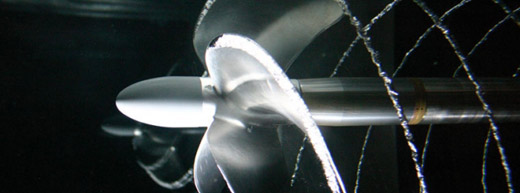
Our Cavitation Research Laboratory is unique in Australia and one of a handful of such experimental laboratories in the world.
It is used to test the hydrodynamic behaviour of submerged structures such as submarines and ship hulls, helping understand how water flows around an object and causes cavitation—the formation of bubbles.
Cavitation is a violent and noisy process that can affect operability and longevity of equipment, as well as cause noise pollution and problems for vessels that require low noise levels for their survival.
The Cavitation Research Laboratory plays a key role when providing research and advice on the future development of submarines, destroyers, patrol boats and other maritime vessels. It is used heavily by defence and related industries to understand how to reduce the effects of cavitation.
Research undertaken at AMC investigates marine propulsors and control surfaces, as well as mechanisms for air entertainment about ship hulls, the effects of propellers and control surfaces in mixing and bubble breakup, and subsequent dispersion and dissipation of bubbles in the ship wake.
Cavitation tunnel
Our cavitation tunnel is a variable pressure water tunnel for the study of cavitating and bubbly viscous flows.
It is the most sophisticated medium-sized variable-pressure water tunnel in the world for experimental modelling of cavitation physics.
At a Glance:
Test section | 0.6 m square x 2.6 m long |
Max flow speed | 12 m/s |
Pressure range | from 4 to 400 kPa absolute |
Tunnel volume | 365 m3 |
Bubble Dynamics Chamber
The Bubble Dynamics Chamber is used for basic studies of bubble behaviour in stationary or small scale flows. It complements the research undertaken in the Cavitation Tunnel, achieving similar test conditions to the tunnel in terms of pressure range, dissolved gas content, nuclei and microbubble injection.
The facility is developed in collaboration with and funded by the Defence Science and Technology Organisation.
At a Glance:
Chamber dimensions | 0.5 m square by 1.2m long |
Pressure range | from 4 to 400 kPa absolute |
Optical access | equivalent to cavitation tunnel |
AMC Videos
Media
Bubble Behaviour - ABC Catalyst program Thursday, 29 March 2012
Ship's propellers can be eaten away by explosions of tiny bubbles. Mark Horstman visits a testing facility at the Australian Maritime College in Tasmania to discover how the destruction can be avoided.